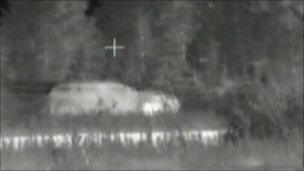Tanks test infrared invisibility cloak
- Published

The heat masking technology can make a tank look like a car to a heat 'scope
Tanks could soon get night time invisibility thanks to a cloaking device that masks their infrared signature.
Developed by BAE Systems, the Adaptiv technology allows vehicles to mimic the temperature of their surroundings.
It can also make a tank look like other objects, such as a cow or car, when seen through heat-sensitive 'scopes.
Researchers are looking at ways to make it work with other wavelengths of light to confer true invisibility.
Hiding out
The hi-tech camouflage uses hexagonal panels or pixels made of a material that can change temperature very quickly. About 1,000 pixel panels, each of which is 14cm across, are needed to cover a small tank.
The panels are driven by on-board thermal cameras that constantly image the ambient temperature of the tank's surroundings. This is projected on to the panels to make it harder to spot. The cameras can also work when the tank is moving.
Its developers would not discuss exactly how the panels are heated and cooled.
Field trials of the thermal cloaking system showed that it made a tank resemble background scenery best from a distance of 300-400m.

Adaptiv is based around hexagonal panels made of a thermo-electric material.
BAE Systems has also produced a library containing the heat images of other objects, such as trucks, cars and large rocks, that can be projected on to the panels.
"Earlier attempts at similar cloaking devices have hit problems because of cost, excessive power requirements or because they were insufficiently robust," said Adaptiv project manager Pader Sjolund at BAE Systems in a statement.
By contrast, he explained, Adaptiv panels add to the armour on a fighting vehicle and consume relatively little power.
"We can resize the pixels to achieve stealth for different ranges," he added. "A warship or building, for instance, might not need close-up stealth, so could be fitted with larger panels."
BAE estimates that the technology could be ready to put into production in two years.
- Published6 July 2011
- Published24 June 2011
- Published4 November 2010